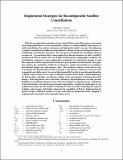| dc.contributor.author | Straub, Alexandra N. | |
| dc.contributor.author | Hastings, Daniel E. | |
| dc.contributor.author | Miller, David W | |
| dc.contributor.author | de Weck, Olivier L | |
| dc.date.accessioned | 2021-05-12T18:55:05Z | |
| dc.date.available | 2021-05-12T18:55:05Z | |
| dc.date.issued | 2020-11 | |
| dc.identifier.isbn | 9781624106088 | |
| dc.identifier.uri | https://hdl.handle.net/1721.1/130579 | |
| dc.description.abstract | With the emerging democratization of space, Earth Observation (EO) imagery is becoming increasingly important to a variety of industries. However, it remains difficult and expensive to build constellations that achieve continuous and high-quality global coverage. Reconfiguring a satellite constellation into different orbital planes to change its observational performance is traditionally a fuel intensive procedure. The concept of a reconfigurable constellation (ReCon) accounts for J2 perturbation effects when making fuel efficient maneuvers to shift a satellite’s ground track. ReCon reduces the cost of high revisit frequency, high-quality resolution, EO constellations compared to nonreconfigurable constellations by reducing the number of satellites required to achieve repeated observations of a given ground event on demand. This paper first explores the sensitivities of ReCon’s performance against uncertainties in reconfiguration demand, design costs, and imagery value. The sensitivity analysis reveals that in cases of extremely low demand, ReCon fails to provide a cost-effective solution in terms of events responded to per dollar spent. In cases of high demand ReCon fails to meet demand altogether. A Monte Carlo analysis over a range of demand scenarios shows using a staged deployment for ReCon offers a flexible, cost-effective solution to the uncertainties in the demand of EO imagery. Deferring launch costs to the future, through a staged deployment, not only provides flexibility in constellation design, but also allows the designer to capitalize on the continuation of lowering launch costs and increasing launch opportunities. Staging the deployment of constellations also allows for the satellites’ technology to evolve over time, facilitating the capture of higher value imagery and further enhancing the capabilities of ReCon. Implementing the option to deploy additional satellites in stages makes ReCon significantly better equipped to respond to the uncertainty in the demand of space assets. | en_US |
| dc.language.iso | en | |
| dc.publisher | American Institute of Aeronautics and Astronautics | en_US |
| dc.relation.isversionof | http://dx.doi.org/10.2514/6.2020-4246 | en_US |
| dc.rights | Creative Commons Attribution-Noncommercial-Share Alike | en_US |
| dc.rights.uri | http://creativecommons.org/licenses/by-nc-sa/4.0/ | en_US |
| dc.source | Prof. Hastings via Barbara Williams | en_US |
| dc.title | Deployment Strategies for Reconfigurable Satellite Constellations | en_US |
| dc.type | Article | en_US |
| dc.identifier.citation | Straub, Alexandra N. et al. "Deployment Strategies for Reconfigurable Satellite Constellations." Accelerating Space Commerce, Exploration, and New Discovery Conference, November 2020, virtual event, American Institute of Aeronautics and Astronautics, November 2020. © 2020 Daniel Hastings | en_US |
| dc.contributor.department | Massachusetts Institute of Technology. Department of Aeronautics and Astronautics | en_US |
| dc.relation.journal | Accelerating Space Commerce, Exploration, and New Discovery Conference | en_US |
| dc.eprint.version | Author's final manuscript | en_US |
| dc.type.uri | http://purl.org/eprint/type/ConferencePaper | en_US |
| eprint.status | http://purl.org/eprint/status/NonPeerReviewed | en_US |
| dc.date.updated | 2021-05-11T18:21:00Z | |
| dspace.orderedauthors | Straub, AN; Hastings, DE; Miller, DW; Deweck, OL | en_US |
| dspace.date.submission | 2021-05-11T18:21:05Z | |
| mit.license | OPEN_ACCESS_POLICY | |
| mit.metadata.status | Complete | |
